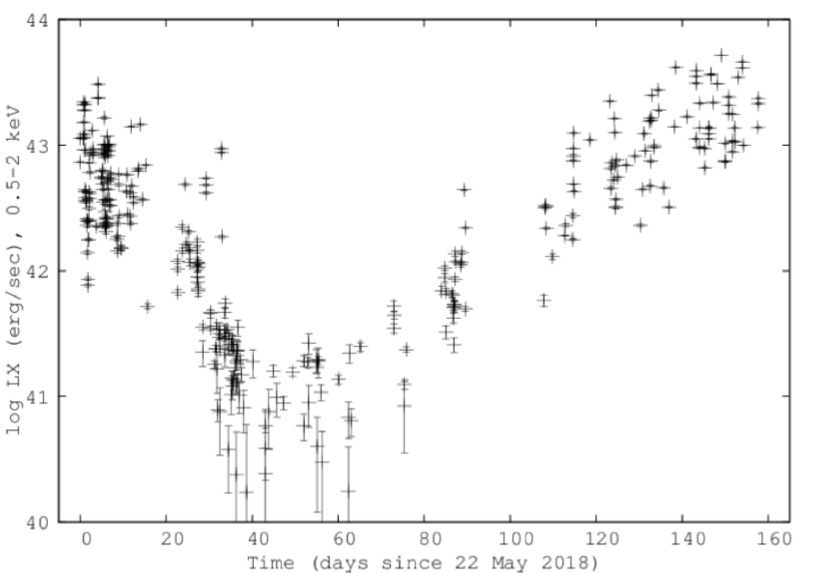NICER / ISS Science Nugget for November 8, 2018Unexplained X-ray transient event in active galaxy observed by NICEROn the 3rd of March, 2018, the All-Sky Automated Survey for SuperNovae (ASAS-SN) discovered a new visible-light transient, which they named ASASSN-18el. This transient appeared to originate in a local Seyfert galaxy called 1ES 1927z+654. The NICER team's optical collaborators performed spectroscopic follow-up observations and discovered that the transient was not associated with a supernova explosion as originally thought, but rather was due to a change in the accretion activity of the supermassive black hole at the center of the galaxy. The question arose: what instigated this dramatic change in the active galactic nucleus (AGN)? This is where NICER could help. One way to dramatically increase the luminosity output from a black hole is to feed it a single star. This is known as a Tidal Disruption Event (TDE), and it has been shown to dramatically increase the luminosity from a galactic nucleus for several months before decaying back to its quiescent state. The X-ray spectra of such events usually consist of a ~105-106 Kelvin thermal component, likely from a newly formed accretion disc around the black hole. This spectrum is very different from a normal AGN spectrum in X-rays, which nearly always shows a hard X-ray spectrum in the 0.1-100 keV photon energy range. With NICER, we hoped to understand if the transient ASASSN-18el was due to normal AGN variability (and thus had a hard X-ray spectrum) or if it was instead due to a tidal disruption event (which would have a soft thermal spectrum that decayed in luminosity over time). NICER began observing the source on May 22, 2018. The X-ray spectrum was extremely soft, well described by a 106 K thermal spectrum, typical of a TDE. Moreover, over the next two months, the net luminosity dropped by over two orders of magnitude, also as expected from a TDE. Then, in August, just as the source was becoming too dim to be detected with NICER, it began to increase in flux again, and now, as of a few days ago, it is brighter than when we initially began observing in May (see accompanying figure). If this event is a TDE, it is unlike anything we have ever seen. We are still investigating, modelling the NICER, optical, and Hubble Space Telescope spectra that we have obtained, and coordinating simultaneous observations with new facilities to understand the nature of this truly unprecedented behavior from an AGN.
This result was reported in NICER's 19th Astronomer's Telegram (ATel #12169) and has prompted multiple ground-based optical (variability, spectroscopy, and polarimetry) follow-up observations around the world. NICER
|



